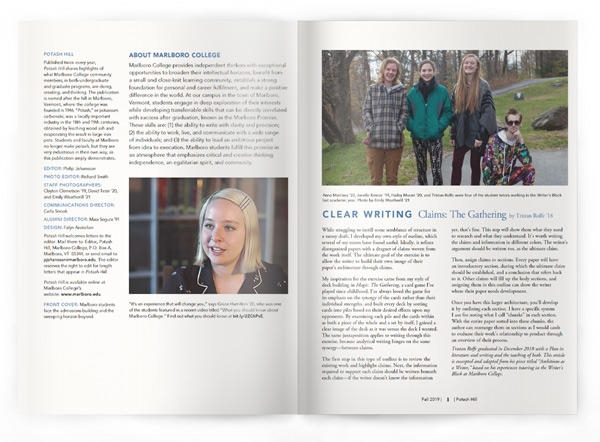Clear Writing

Claims: The Gathering
by Tristan Rolfe ’18
While struggling to instill some semblance of structure in a messy draft, I developed my own style of outline, which several of my tutees have found useful. Ideally, it refines disorganized papers with a dragnet of claims woven from the work itself. The ultimate goal of the exercise is to allow the writer to build their own image of their paper’s architecture through claims.
My inspiration for the exercise came from my style of deck building in Magic: The Gathering, a card game I’ve played since childhood. I’ve always loved the game for its emphasis on the synergy of the cards rather than their individual strengths, and built every deck by sorting cards into piles based on their desired effects upon my opponents. By examining each pile and the cards within as both a piece of the whole and a set by itself, I gained a clear image of the deck as it was versus the deck I wanted. The same juxtaposition applies to writing through this exercise, because analytical writing hinges on the same synergy—between claims.
The first step in this type of outline is to review the existing work and highlight claims. Next, the information required to support each claim should be written beneath each claim—if the writer doesn’t know the information yet, that’s fine. This step will show them what they need to research and what they understand. It’s worth writing the claims and information in different colors. The writer’s argument should be written too, as the ultimate claim.

Then, assign claims to sections. Every paper will have an introductory section, during which the ultimate claim should be established, and a conclusion that refers back to it. Other claims will fill up the body sections, and assigning them in this outline can show the writer where their paper needs development.
Once you have this larger architecture, you’ll develop it by outlining each section. I have a specific system I use for noting what I call “chunks” in each section. With the entire paper sorted into these chunks, the author can rearrange them in sections as I would cards to evaluate their work’s relationship to product through an overview of their process.
Tristan Rolfe graduated in December 2018 with a Plan in literature and writing and the teaching of both. This article is excerpted and adapted from his piece titled “Ambitions as a Writer,” based on his experiences tutoring in the Writer’s Block at Marlboro College.
